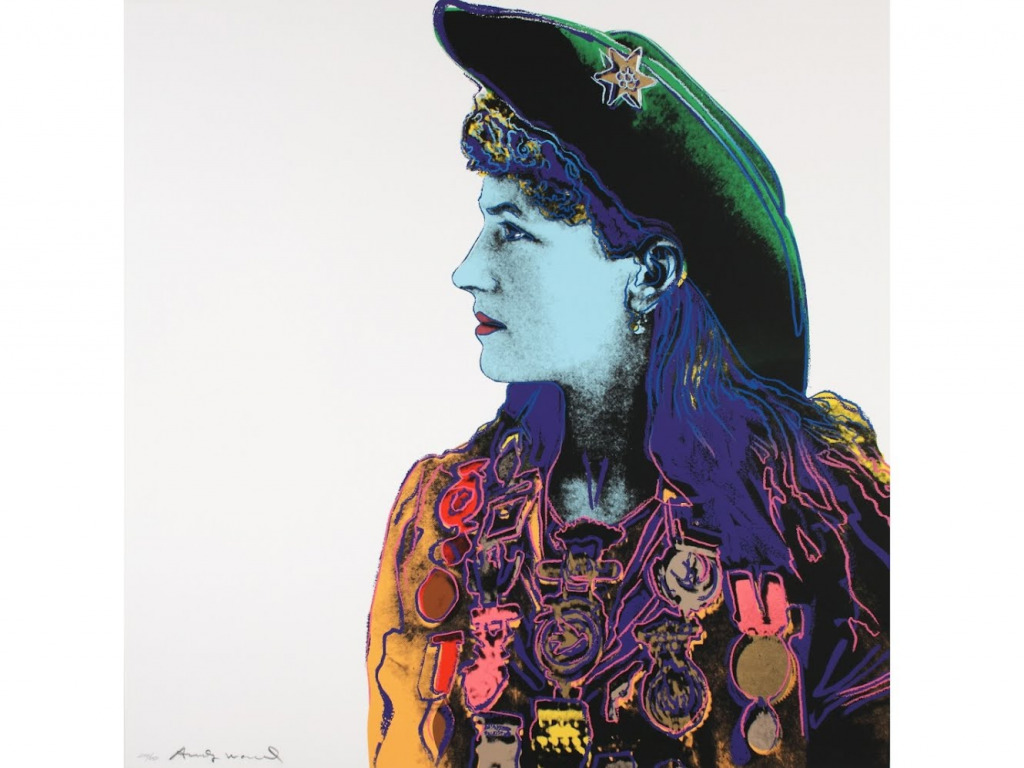Subscriber Benefit
As a subscriber you can listen to articles at work, in the car, or while you work out. Subscribe Now
After creating popular silkscreen prints in the 1960s inspired by Marilyn Monroe, Elvis Presley and Liz Taylor, Andy Warhol devoted part of his 1980s to a series of colorful prints titled “Cowboys and Indians.”
Images of historical figures ranging from Teddy Roosevelt and Annie Oakley to Sitting Bull and Geronimo are highlights of “Warhol’s West,” an exhibition that opens March 12 at the Eiteljorg Museum of American Indians and Western Art.
Although Warhol’s fascination with the American West is evident in the traveling exhibition, it’s difficult to know how he perceived the subjects of “Cowboys and Indians,” said Johanna Blume, curator of Western art, history and culture at the Eiteljorg.
Cavalry commander George Custer, for instance, is depicted alongside Apache leader Geronimo and actor John Wayne.
“The juxtaposition can be very hard to process,” said Blume, noting Custer’s role in killing Native Americans after the Civil War. “There are a lot of mixed reactions to this series, a lot of deeply emotional reactions.”
Completed in 1986 and considered Warhol’s final major series of prints before his death one year later, “Cowboys and Indians” adheres to the artist’s tradition of elevating people and things—including Chinese Chairman Mao Zedong and boxes of Brillo scouring pads—to iconic status.
To make an image of Oscar-winning actor Wayne, Warhol worked from a publicity still that advertised 1962 film “The Man Who Shot Liberty Valance.” Oakley became famous as a sharpshooter in Buffalo Bill’s Wild West show.
The popularity of Western-themed movies and TV shows during Warhol’s lifetime likely influenced the mix of entertainers and warriors seen in the “Cowboys and Indians” series, Blume said.
“Warhol was always deliberately vague about the meaning and intent behind his work,” she said. “There are some scholars who wonder, ‘Was he sort of poking fun at his audience with some of this work?’ ”
Blume said it’s up to visitors to interpret the context of “Warhol’s West,” which includes 14 screenprints from the “Cowboys and Indians” series.
“There’s so much that’s ambiguous about the work,” she said. “I think that’s one of the things that makes it exciting and interesting.”
The exhibition will be the first major showing of Warhol’s work in central Indiana in more than a decade. The Indianapolis Museum of Art hosted “Andy Warhol Enterprises” in 2010, and the IU Art Museum in Bloomington hosted the “Shot By Warhol” photo exhibition in 2011.
Thirty-five years after his death, Warhol remains one of the most recognizable names in contemporary art.
“We don’t get to talk about something like Pop Art very often,” Blume said. “It’s not something people necessarily associate with the American West. This is an opportunity for us to show that art of the American West is more than just realist art. I think it’s a fun chance for us to flex and show there are so many interesting stories to tell.”
The Eiteljorg’s collection includes a Warhol drawing of Native American activist Russell Means, which will be included as part of “Warhol’s West.”
In 2019, a Warhol silkscreen depicting Means sold for $6.3 million at a Sotheby’s auction.
The museum’s collection of photogravures by Edward S. Curtis, a photographer whose work focused on the American West in the 19th and 20th centuries, also will be represented in “Warhol’s West.” Warhol was an avid collector of Curtis photos, Blume said.
“We wanted to include those to talk a little bit about what inspired Warhol and this lifelong interest he had in Native American cultures and in Native American art,” she said. “He collected Native American customary art and Western art, too. He lived with it. It was very much a part of his life.”
“Warhol’s West”
- When: March 12 through Aug. 7.
- Where: Eiteljorg Museum of American Indians and Western Art, 500 W. Washington St.
- Tickets: Free with museum admission of $15.
- Info: Visit eiteljorg.org.
Please enable JavaScript to view this content.
